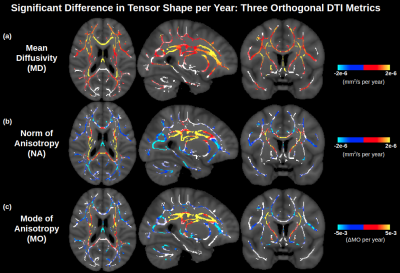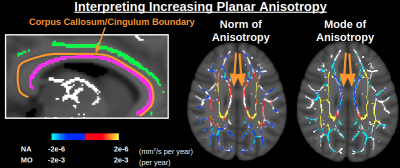Jordan A. Chad1,2, Ofer Pasternak3, and J. Jean Chen1,2
1Rotman Research Institute, Baycrest Health Sciences, Toronto, ON, Canada, 2Department of Medical Biophysics, University of Toronto, Toronto, ON, Canada, 3Brigham and Women's Hospital, Harvard Medical School, Boston, MA, United States
1Rotman Research Institute, Baycrest Health Sciences, Toronto, ON, Canada, 2Department of Medical Biophysics, University of Toronto, Toronto, ON, Canada, 3Brigham and Women's Hospital, Harvard Medical School, Boston, MA, United States
An orthogonal diffusion tensor decomposition based on the moments of its eigenvalues is used to assess aging white matter, and is found to be more sensitive to age in complex fibre architecture than the conventional non-orthogonal decomposition.

Figure 2. Significant age associations of orthogonal DTI metrics (MD, NA, MO) across the WM skeleton. NA exhibits more positive age associations than FA (Figure 1), and these positive age associations of NA largely overlap with positive age associations of MO. The contrast is the effect size of metric per year derived from a linear regression and displayed only in voxels with significant correlations with age. Voxels of the WM skeleton without significant age associations are displayed in white.

Figure 4. Interpreting positive age associations of planar anisotropy in the corpus callosum body. The corpus callosum body (callosum skeleton outlined in purple) directly borders the cingulum (cingulum skeleton outlined in green), which can lead partial volume effects within the TBSS skeleton. Here the norm of anisotropy (NA) is positively associated with age while the mode of anisotropy (MO) is negatively associated with age, consistent with alterations in more than one tract in aging.